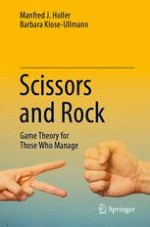2020 | OriginalPaper | Buchkapitel
5. Sequence of Moves and the Extensive Form
verfasst von : Manfred J. Holler, Barbara Klose-Ullmann
Erschienen in: Scissors and Rock
Verlag: Springer International Publishing
Aktivieren Sie unsere intelligente Suche, um passende Fachinhalte oder Patente zu finden.
Wählen Sie Textabschnitte aus um mit Künstlicher Intelligenz passenden Patente zu finden. powered by
Markieren Sie Textabschnitte, um KI-gestützt weitere passende Inhalte zu finden. powered by
